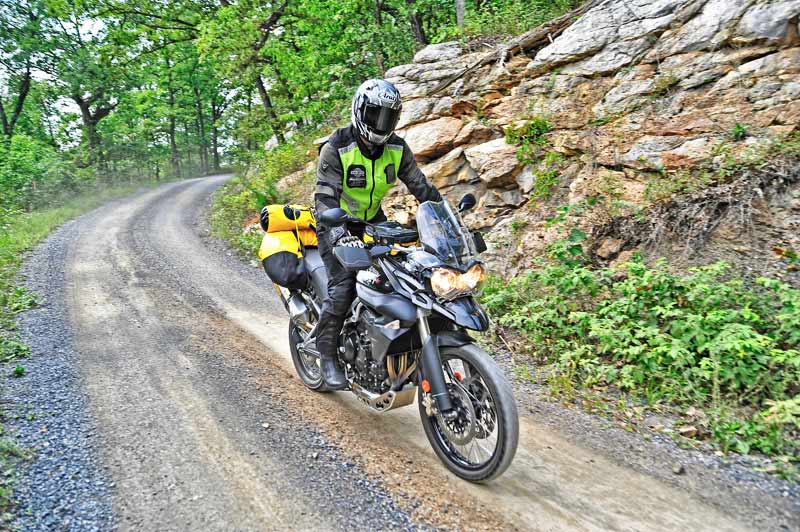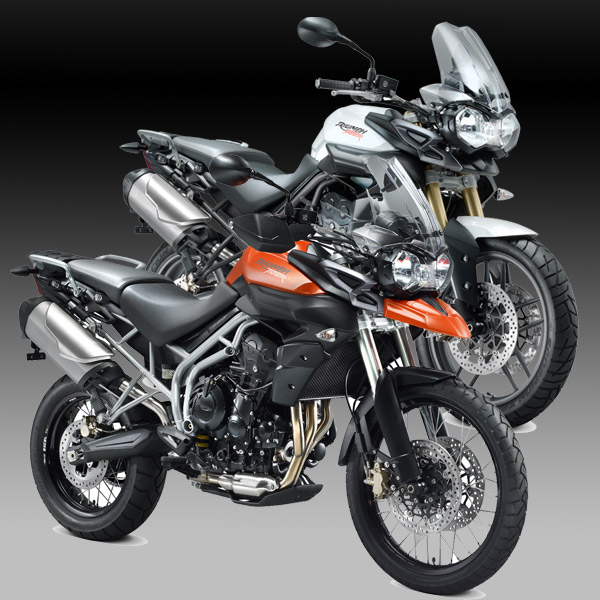Review: 2011 Triumph Tiger 800XC
Article Index
In the world of North American adventure motorcycling, there hasn’t been much to choose from, with the exception of BMW’s hugely successful GS bikes. Oh how the times are changing! Triumph has boldly stepped into the ring to try and capture a share of the only growing section of the North American motorcycle market. With modern technology, sharp looks and European styling, the introduction of the Tiger 800XC is just the beginning.
COMFORT AND ERGONOMICS
When I first threw a leg over the Tiger 800XC, we instantly felt at home on the machine. Coming from a mostly dirt background, the bike has a very off-road-bike-like riding position for its size. The Tiger’s wide handlebar stance made controlling the 470lb cat an easy exercise when the going gets rough, but slowed handling a bit on the pavement. Standing up, the narrow tank-to-seat union allowed ample room to move while standing. Seated, the narrow tank-to-seat area makes for a roomy cockpit.
Triumph did a good job on the saddle overall, but some testers complained about the seat being uncomfortable after a few hours in the saddle. We think a quick fix for this would be to simply widen and contour the back half of the seat, but we hear Corbin will bring out an option before too long. A very useful feature the Tiger 800XC incorporates in to the saddle height from 33.2 to 34 inches and one inch less for the Tiger 800.
Narrow at the saddle and a little wider up front, the Tiger’s in-line triple spreads the bikes girth a bit and can make for some toasty knees. Some noted a lot of contact with their lower legs on the engine cases and a fair amount of heat coming from the engine. In the summer heat, this may be a little much for some, but it personally didn’t detract enough from the experience to matter, and the extra heat would probably be enjoyed on a cold, damp morning.
Everybody knows comfort in the wind is subjective, and dependent on a myriad of factors. Our test riders from 5’7” to 6’0” plus felt the Tiger’s screen did a decent job at keeping the wind at bay during off road or around town riding, but there’s only so much a small fairing can do at high speeds. Nevertheless, the Tiger’s minimalist fairing was large enough to protect the gauge cluster, some accessories and tank back. To do a little more for the rider, ADVMoto installed the Touratech adjustable wind screen mount, and found that at highway speeds, the cockpit had less turbulence making this, or any taller windscreen, a must have addition for those who favor high speed extended touring.
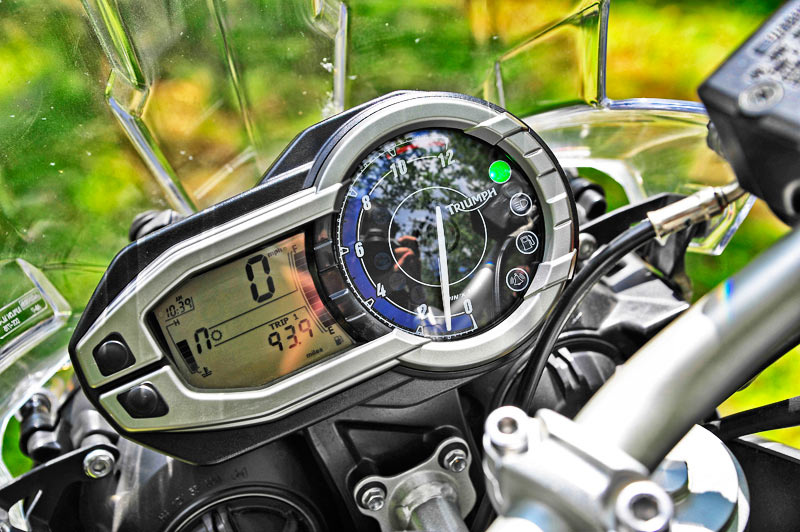 The digital speedometer and analog tachometer cluster is very user friendly, large and easy to read, night or day. Unlike some of BMW’s models, the Tiger doesn’t have any rider selectable fields which can be actuated at the grip, but the information is well laid out and easy enough to change on the cluster itself. At night, the twin Tiger eyes cast a usable wide light pattern in both low and high beam settings. A nice feature on the left side switch cluster is a passing trigger that the staff at ADVMoto found handy. We’re not sure why these have been absent on bikes in North America for so long, but we’re glad to see them coming around. Handlebar controls and switches are pretty standard layout and, with the exception of a rather flimsy turn signal button, all worked well.
The digital speedometer and analog tachometer cluster is very user friendly, large and easy to read, night or day. Unlike some of BMW’s models, the Tiger doesn’t have any rider selectable fields which can be actuated at the grip, but the information is well laid out and easy enough to change on the cluster itself. At night, the twin Tiger eyes cast a usable wide light pattern in both low and high beam settings. A nice feature on the left side switch cluster is a passing trigger that the staff at ADVMoto found handy. We’re not sure why these have been absent on bikes in North America for so long, but we’re glad to see them coming around. Handlebar controls and switches are pretty standard layout and, with the exception of a rather flimsy turn signal button, all worked well.
One of the biggest faults of the Tiger 800 is actually its plastic and rubber trim. Our test bike, with only 3000 miles, was showing signs of problems with the gas tank trim, which was pulling away from the metal. The rear chin guard and hand deflectors could also be more robust, but these can be easily replaced if desired. Considering this is a first generation bike, some fit and finish problems like this can be expected, but we’ll be looking for improvements in these areas down the road.
ENGINE AND PERFORMANCE
Triumph’s goal was to make a strong multi-purpose engine, and what they came up with is exactly that. Although sharing the same basic platform found in the 675 Daytona and Street Triple, it’s mostly a new power plant. The Tiger triple mill generates power at the top end more like an inline four without sacrificing too much of the low end torque commonly found in twins, like its closest competitor, the BMW F800GS. With a longer crank throw (increased to reach 799cc’s), it makes for a slower revving easy-to-use power curve with 70% of the torque available below 4,000rpm. The 74mm bore size remains with slightly different crowning on the pistons to work better with the new combustion chambers sporting lower compression ratios (11.1:1 from 12.7:1). The resulting motor has plenty of pull across the power band so if you’re chugging along in fourth gear at 2,500 rpm, all it takes is a quick twist of the throttle to get up to speed.
Triumph claims the Tiger motor produces 94bhp at 9,300 rpm with a peak torque of 58 ft-lb at 7850 rpm, but we did our own research by heading over to RnR Cycles for some dyno time. Our results varied slightly from Triumph’s which made us think the quoted output numbers are taken at the crank. At the wheels, we got peaks of 84.7bhp at 9,900rpm and a table-top flat torque curve you could eat off of cranking out 51 ft-lb at 7,100rpm. Our test bike from Triumph came with a nicely finished Arrow exhaust which may have helped the numbers. A couple horsepower aside, the biggest benefit would probably be weight savings and a nicer exhaust note.
Looking at the overall package, we’d have to guess Triumph put the greatest amount of emphasis on making this engine just right... and that’s only smart. The throttle response doesn’t have any of the disturbing “on and off” feeling that many fuel injected bikes exhibit, especially in their debut years. Smooth and strong, with a slick shifting transmission that doesn’t miss a beat, this young Tiger has a promising start.
BRAKING AND HANDLING
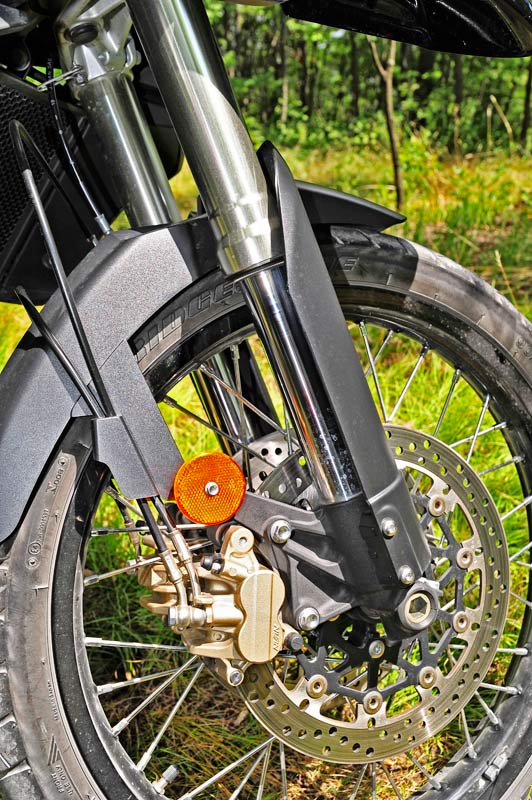 Between the Tiger 800XC and its XC-less sibling, the Tiger 800, their biggest difference is in the suspension and wheels. The Tiger 800XC gets a larger 21" front wheel with spokes and tubes all around. The Tiger 800 receives a cast alloy 19" front wheel, tubeless tires and a slightly shorter suspension which leads to a lower ride height, quicker turning and more pleasant street manners. You could really take the Tiger 800 on many of the same roads but if you spend more time on dirt, or have inseam to spare, the XC is definitely the way to go. Should, however, an enterprising rider want the best of both worlds, an XC front hub could be laced to a 19” rim for a fun and quick character change.
Between the Tiger 800XC and its XC-less sibling, the Tiger 800, their biggest difference is in the suspension and wheels. The Tiger 800XC gets a larger 21" front wheel with spokes and tubes all around. The Tiger 800 receives a cast alloy 19" front wheel, tubeless tires and a slightly shorter suspension which leads to a lower ride height, quicker turning and more pleasant street manners. You could really take the Tiger 800 on many of the same roads but if you spend more time on dirt, or have inseam to spare, the XC is definitely the way to go. Should, however, an enterprising rider want the best of both worlds, an XC front hub could be laced to a 19” rim for a fun and quick character change.
The stock Bridgestone Battle Wing tires on the XC were a little disappointing at first, but once off pavement we were pleasantly surprised by how well they worked. Given the XC’s extra off road brawn, we all agreed a 50/50 or 60/40 tire would have better fit the bike’s persona. The twin pot Nissin front calipers clamp down on dual 308mm rotors doing a great job of coming to a halt in a short distance. Front brake lever response is firm with stainless lines throughout that didn’t lock up too easily on tarmac or gravel, while the rear brake response was also firm and linear.
Our tester, Brian Jeffery, comes from a touring background and was a little nervous to throw a leg over the Triumph in the dirt (effectively on street tires) for the first time. Those nerves disappeared in about 10 seconds. He noted, the Tiger 800’s balance of suspension, geometry and linear power delivery is incredibly confidence inspiring off road, and that the front end exhibited less dive than the F800GS bikes he’s ridden thus far. The Tiger’s riding position is so well suited for off road riding, and it’s easy to read what the front end is doing. The Tiger 800XC will absolutely rip with a proper dual sport tire like a Kenda Big Block or Heidenau Scout K60s.
Handling was a little heavier than expected on asphalt, mostly due to its 21" front tire and wide low bars. The Tiger requires hefty steering inputs to get leaned over, but we found that with a little extra effort, the bike does what you want and feels planted. The front suspension, although not adjustable, was impressive for stock. Its oversized inverted Showa 45mm forks (2mm larger than the non-XC) traveled nicely and showed minimal flexing or twisting in corners. Stock settings stayed well balanced through side-to-side transitions and over large bumps. It would have been nice to see front forks have at least preload adjustment at this price point (the BMW F800GS has both preload and rebound), but we figure the next revision, or the aftermarket, will provide this feature.
LUGGAGE
Although our bike wasn’t available for long term testing, the Tiger’s long, flat rear seat and ample grab rails (which have thoughtfully molded hook stops) make strapping on luggage an easy chore. Our Giant Loop Coyote bag setup was in perfect proportion to the body and it could have easily taken more. The lack of plastics in the bike’s stern portion not only saves weight, and is one less thing to crack, but provides bungee mounting options galore. With the addition of a rack and side cases, now available through suppliers like Twisted Throttle and Touratech, there’s no lack of storage for whatever you may need to bring—which is almost always too much!
ADVMOTO DYNO RESULTS
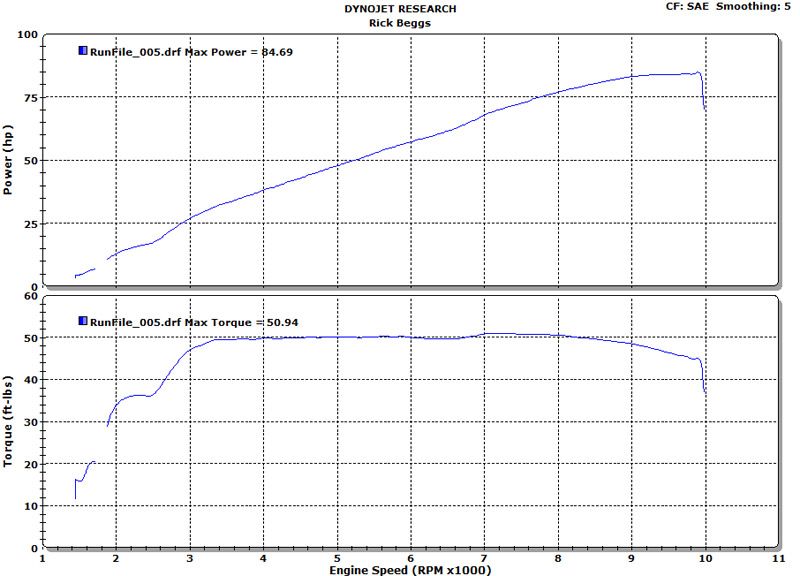
CONCLUSION
With various riders from different backgrounds, the Triumph inspired confidence in each of our weaknesses, both on road and off. With its thoughtful balance of features and one dynamite engine, it could be the coolest thing to come across the pond since the Beatles. How does it compare to the BMW F800GS? While they’re spec’d very closely to each other, they’re not the same bike, if for no other reason than the unique triple pump at the Tiger’s heart. Each has a character of its own which may, or may not, fit your riding style, so it’s best to check them out for yourself and make your own decision.
Triumph accomplished a lot considering this is a first generation model, but the success of the line lies years away, and the trial by fire of real world use and abuse. We look forward to tracking Triumph’s Tiger through the upcoming years and we’re already looking at yet another Tiger 1200 Explorer due out in 2012. Creating innovative products that people can get excited about, and can use every day, is the difference between a bike that’s a statement, and one that’s a companion. TriumphMotorcycles.com
PROS | CONS |
| ▲ Silky smooth motor and transmission | ▼ Triumph should have opted for more aggressive 60/40 tire choice |
| ▲ Little, to no vibration passed on to rider | ▼ Seat uncomfortable for more than a couple of hours in the saddle |
| ▲ Aggressive styping and looks | ▼ Trim pieces and upper fairing plastic could have been better constructed |
TRIUMPH TIGER 800XC TECH SPECS
| ENGINE | Liquid cooled, transverse inline triple | TIRES FRONT/REAR | 99/90/ZR21; 150/70-ZR17 |
| DISPLACEMENT | 799cc | CURB WEIGHT | 473 lbs. |
| BORE AND STROKE | 74x61.9mm | WHEELBASE | 61.7 in. |
| FUEL DELIVERY | Multiport sequential electronic fuel injection | OVERALL HEIGHT | 53.1 in. |
| POWER | 94hp @ 9,300rpm, 58lb-ft of torque @ 7,850rpm | OVERALL LENGTH | 87.1 in. |
| COOLING | Liquid | OVERALL WIDTH | 34.0 in. |
| IGNITION | Digital-inductive type via engine management system | SEAT HEIGHT | 33.2-34.0 in. Two piston adjustment |
| TRANSMISSION | 6-speed, cable actuated wet clutch | FUEL CAPACITY | 5.0 gal |
| FRAME | Steel trellis and two-sided cast aluminum swing arm | WARRANTY | 24 months |
| FRONT SUSPENSION | 45mm Showa upside down forks 8.7 in. of travel | COLORS | Phantom Black, Crystal White, Intense Orange |
| REAR SUSPENSION | Showa monoshock with remote oil reservoir, hydraulically adjustable preload rebound damping adjustment, 8.46 in. of travel | TIGER 800XC MSRP | $10,999 |
| RAKE/TRAIL | 23.1 degrees, 3.6 in. | TIGER 800 MSRP | $9,999 |
| BRAKES FRONT/REAR | Twin 3008mm floating discs, Nissin 2 piston floating calipers/single. Rear, 255mm disc, Nissin single floating caliper (ABS available) | ABS OPTION | $800 |
https://adventuremotorcycle.com/bikes/bikes-review-2011-triumph-tiger-800xc/all-pages#sigProId4131131d92


